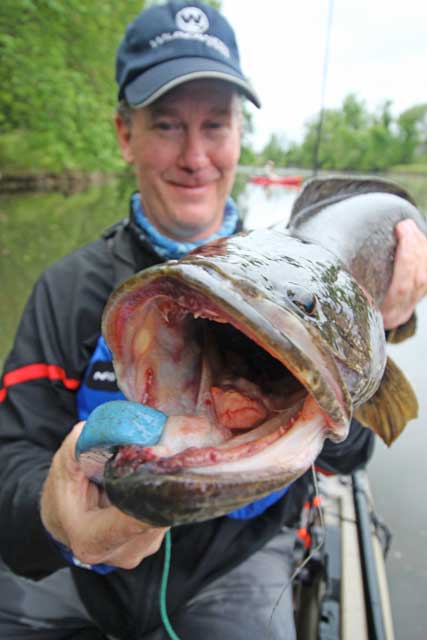Pike, pickerel and musky are long, slender, predatory fish, popular with anglers for their aggressive attacks, size and for their spectacular leaps. Members of the pike family native to North America include the grass pickerel, redfin pickerel, chain pickerel, northern pike and the muskellunge. These unique fish range in size from 12 inch pickerel to monster muskies that sometimes exceed 50 lbs.
The redfin and grass pickerel are the smallest members of the pike family, growing to 12 inches at most. The two fish are twin sub species of Esox americanus and are very are similar in appearance. The redfin pickerel is greenish gray to dark olive-bronze on the back, with shading down its sides. The redfin's native range is along the Atlantic Coast from Massachusetts to Florida. In the Gulf Coast and southeast states, it mixes and interbreeds with the grass pickerel.
Grass pickerel have a dark tear drop under their eye, a light stripe down their back and a pattern of blotches or vertical lines on their side. Grass pickerel can be distinguished from northern pike or muskellunge by their lack of spots or dark markings on their fins. The grass pickerel is native throughout the Mississippi River watershed.
Chain pickerel are the smallest game fish of the pike family. They reach a length of 3 feet and weigh up to 7 lbs. The chain pickerel is distinguished from its relatives, the Northern pike and Muskellunge, by its prominent chain-like markings on a green background. They are identified by their fully scaled cheek and gill cover, slender body, large head and conspicuous dark bar beneath each eye.
Northern pike are another member of this family of fish. Their coloration includes a pattern of light markings on a dark green background. Several features distinguish Northern pike from the larger musky. Identification can be made by the pattern of markings, the lower half of the cheek having scales, five pores or less on each side of the underside of the jaw and its rounded tail tips.
The muskellunge is the largest member of the pike family. Their flanks are marked with dark vertical bars on a background ranging from light green to light brown. Muskies can be distinguished from northern pike by the presence of 7 to 11 sensory pores on the underside of each jaw and by cheeks and gill covers scaled only on the upper half
Muskies have a long cylindrical body with a mouth full of fang-like teeth. These efficient predators lurk in the shadows, waiting to ambush prey. Muskies eat perch, suckers, catfish, minnows, sunfishes and other fish. Large individuals are known to consume a variety of animals, including, amphibians, waterfowl and rodents.
Because of its large size and fighting qualities, the muskellunge is one of North America's most renowned game fish.This highly prized trophy fish ranges from the St. Lawrence River and the Great Lakes basin, to areas of Canada in the north and west.A hybrid fish called tiger musky occurs when eggs from a female musky fertilized by a male northern pike. Tigers share some physical characteristics with each parent.
Interview With Snakehead Charmer Joe Bruce

Role of SCUBA Diving Gear in Technical & Recreational Diving

3 Ways to Improve Your Health Over 30

Copyright © www.mycheapnfljerseys.com Outdoor sports All Rights Reserved